There’s a lot of gold and treasure out there, behind armed guards and locked gates. Assemble your team to do the job—but be careful who you hire, because there’s No Honor Among Thieves.
At a glance: No Honor Among Thieves is a heist-themed game for 3 to 5 players, ages 14 and up, and takes 90-120 minutes to play. It’s currently seeking funding on Kickstarter, with a pledge of $45 for a copy of the game. The game is about assembling crews to bypass defenses and negotiating with other players for your share of the take—and, of course, betrayal. The game has backstabbing built into the mechanics, so it’s definitely recommended only for players who are okay with that, though aside from that you could probably go a little younger than 14.
New to Kickstarter? Read our crowdfunding primer.

Components
Note: my review was based on a prototype, so final components may differ depending on the Kickstarter goals reached.
- 35 Character cards
- 96 Scheme cards
- 33 Defense cards
- 18 Hidden Agenda cards
- 12 Treasure cards
- 5 Reference cards
- 13 Objective mats
- 1 Jail/Graveyard mat
- 30 Copper coins
- 20 Silver coins
- 15 Gold coins
- 2 Dagger dice
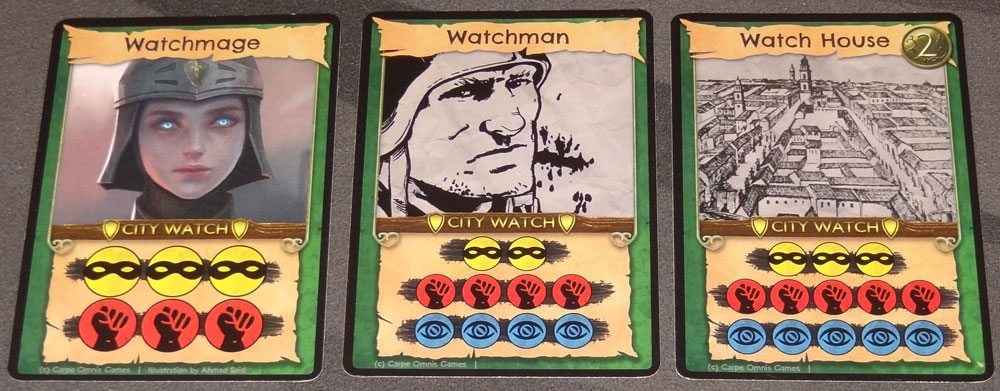
The prototype component quality was not final, but there was artwork in various stages of completion—the parts that look final are pretty nice, but visit the Kickstarter page for the most recent examples. For the most part, I found the cards pretty easy to interpret: Character abilities, Scheme cards, and Defenses were usually fairly straightforward. The “City Watch” Defense cards have a special effect—they change the consequences of failure—and it would be nice to have that chart somewhere other than the rulebook.

One thing that could be nice is some additional tokens matching the skill icons on Defense and Character cards. There are various Scheme cards that make Defenses harder, or temporarily give Characters extra skill points, but there’s not a good way to keep track of those changes (which can sometimes depend on a die roll). It would be nice to have some markers that you could just place on a card to indicate its increased difficulty/skill.
The Dagger dice are custom dice: the faces show 1 or 2 daggers, an X, or blanks, and are used to determine consequences of failing a heist, or for certain Scheme cards.
How to Play
The current draft of the rules is available here. Since the rules may have been updated since the version I received, I’ll give a rough overview of the game without getting into too many specifics.
The goal of the game, as you’d expect, is to get the most money by the end of the game.
To set up, everyone gets 3 Hidden Agenda cards and chooses 2 to keep—these award bonuses if you accomplish them. Each player also gets 5 coins and 4 Scheme cards.
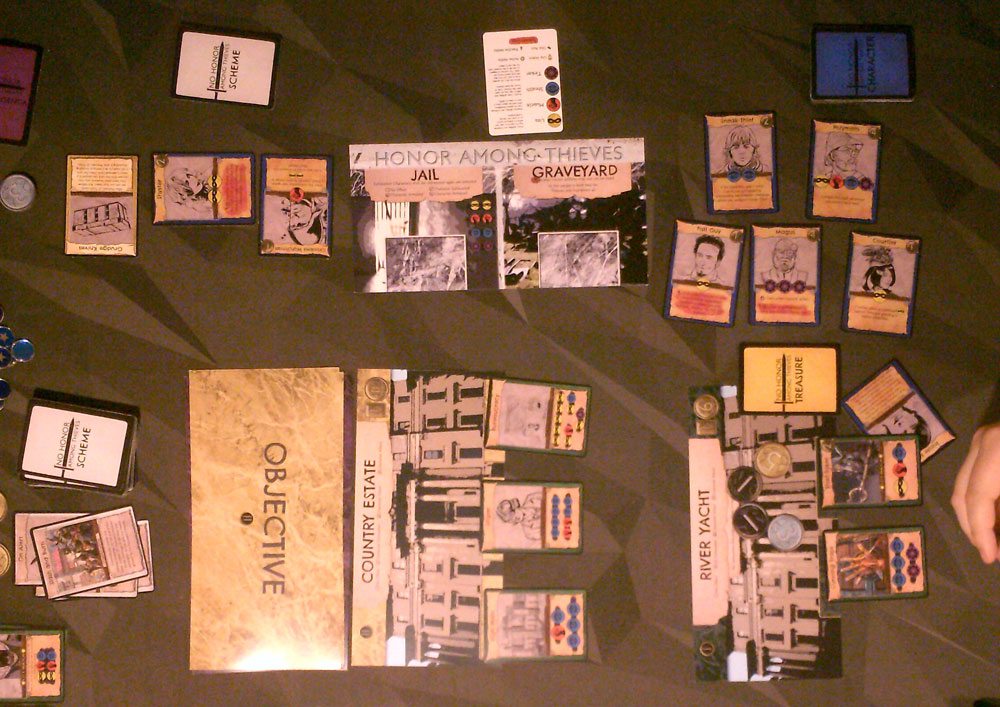
The Objective mats come in three stages, and each stage is shuffled separately. You’ll make a stack so that Stage 1 is on top, followed by Stage 2, then Stage 3, removing a certain number at random. Then two Objectives are turned face up, and Defense cards are drawn for the Objectives (corresponding to the number of slots shown on the mat). The Jail/Graveyard is set to one side with the Jail side face-up. Lay out 2 Characters per player face-up on the table to form the initial hiring pool: players will draft Characters so that each player has 2 starting Characters in their crew. Then put 5 Characters on the table to form the hiring pool, and 3 Characters start in the Jail.
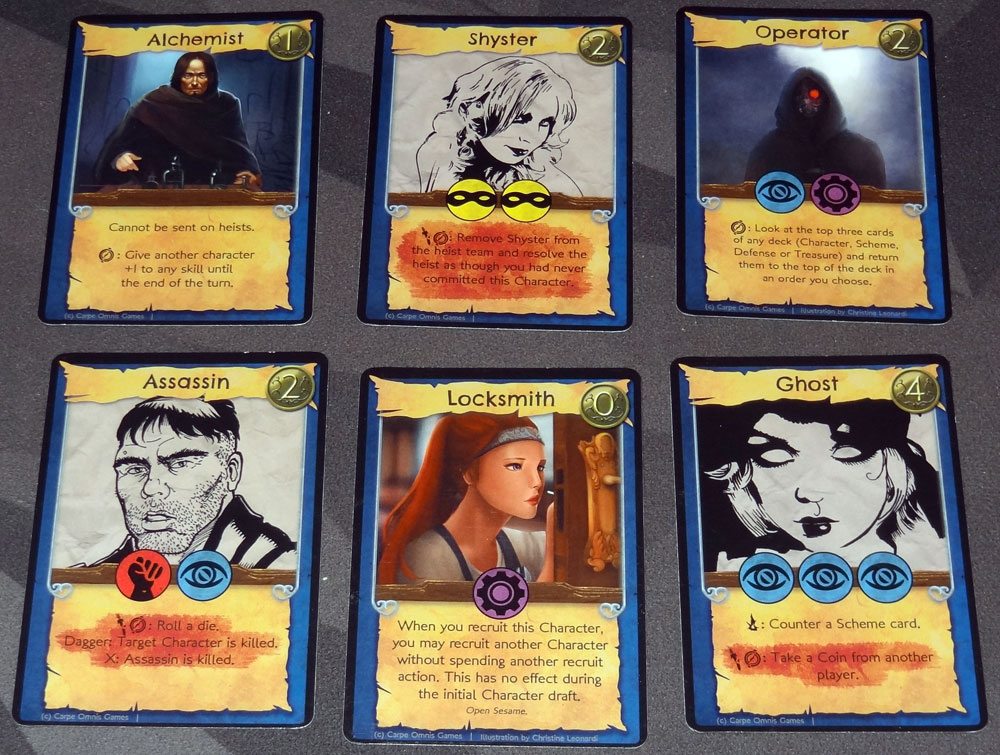
Each turn, you first discard down to 7 Scheme cards, and then take 3 actions, choosing from the following:
- Heist: Launch a heist against an Objective or the Jail (to break out a Character). Only 1 Heist per turn.
- Recruit: Take a Character from the hiring pool, paying its cost, and then draw to replace it. You may only have 4 Characters in your crew.
- Legwork: Draw Scheme cards up to your hand limit of 7.
- Logistics: Play any number of Logistics Scheme cards.
- Rest: Turn all of your exhausted Characters to ready. You may also draw 2 Scheme cards or discard any number of Scheme cards as part of this action.
- Headhunting: Cycle all the Characters in the hiring pool.
- Exchange: Trade cards with other players. You can trade Characters, Scheme cards, and Treasures, but not Hidden Agendas.
There are some things you can do which do not require using actions: using Character abilities, trading coins with other players, and firing Characters by putting them on the bottom of the deck.
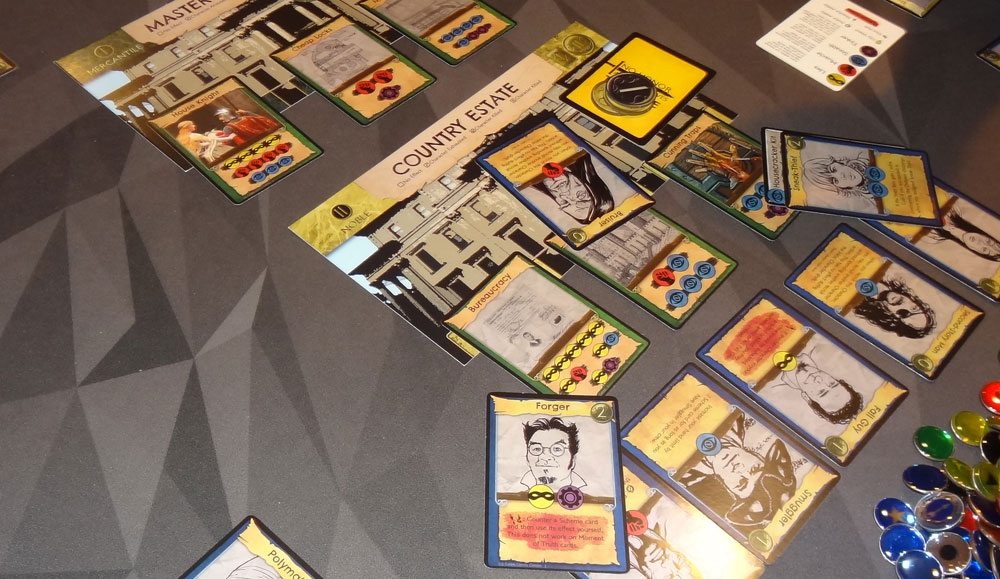
Of course, the biggest action here is going on a heist, which has its own series of steps:
Negotiate: recruit other players if desired, and decide on how the haul will be split. Each Objective shows how many coins it is worth, and some also include Treasure cards, which will give you special abilities.
Send in the Team: Each player involved must play 1 or 2 Characters per Defense card, or they cannot attempt the heist.

Complications: Once all Character cards have been played to the Defenses, everyone takes turn using Character abilities or playing Active or Complication Scheme cards until everyone passes in a row. Players might be able to make Defenses easier or harder, affect Characters, and so on—depending on who is on the heist and who got cut out of the deal. Characters may even be arrested or killed during a heist, in which case they’re removed from the heist and no longer contribute their skills.
Success or Failure: To complete a heist, the Characters involved must have enough skill points (or abilities) to overcome one of the skill challenges shown on the Defense card. A heist is only successful if all Defense cards are overcome. If the heist failed, players can still collect a little money for Defenses that were successfully overcome—those Defenses are discarded and replaced. Any characters at a failed Defense will have to suffer the fate of a die roll—the consequences of failure are listed on the Objective card, and can include characters being exhausted, arrested, or even killed. Whether the heist succeeded or not, 1 coin is added to the other Objective.

Moment of Truth: If there were multiple players involved in a successful heist, there’s a Moment of Truth: everyone puts a Scheme card face-down, and they’re revealed simultaneously. If you play a Moment of Truth Scheme card, it is resolved; all others are just bluffs and are returned to the players’ hands. Moment of Truth cards include betrayal cards, which let you take more than the agreed-upon share of the loot plus any Treasure cards, if any.
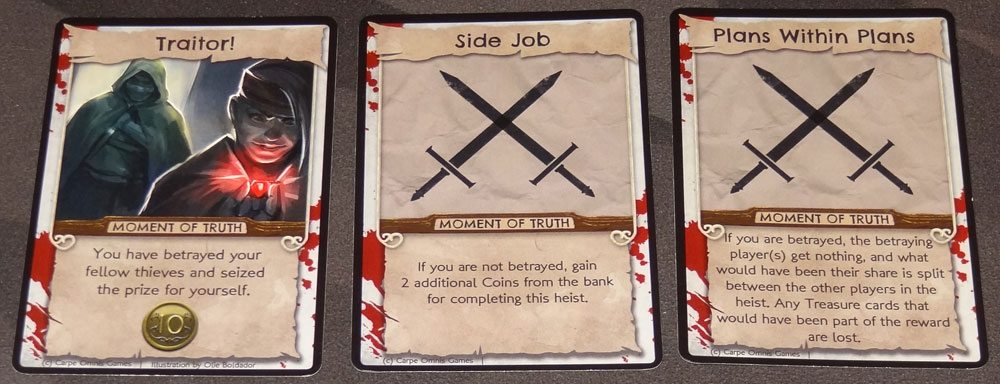
Oh, and as soon as somebody uses a Betrayal card, the Jail/Graveyard is flipped over to the “No Honor” side. Now, consequences of failure get worse, and it also unlocks all of the red-highlighted abilities on Characters and Scheme cards, which tend to be more powerful.
The Jail itself can be heisted—it’s not too difficult, but if you succeed, you may recruit one Character from the Jail for free. Some Character abilities require you to exhaust the Character when using the abilities; other abilities or Scheme cards may also exhaust Characters. Before honor is broken, exhausting a Character who is already exhausted will result in their arrest; after honor is broken, it will kill the Character instead.
Once the Moment of Truth has been resolved, then the loot is divvied up and the Objective is discarded and replaced with a new one.
The game ends as soon as one of the Stage 3 Objectives is successfully heisted. Everyone counts up their coins, adds any bonus coins for their Hidden Agendas, and the player with the most loot wins.
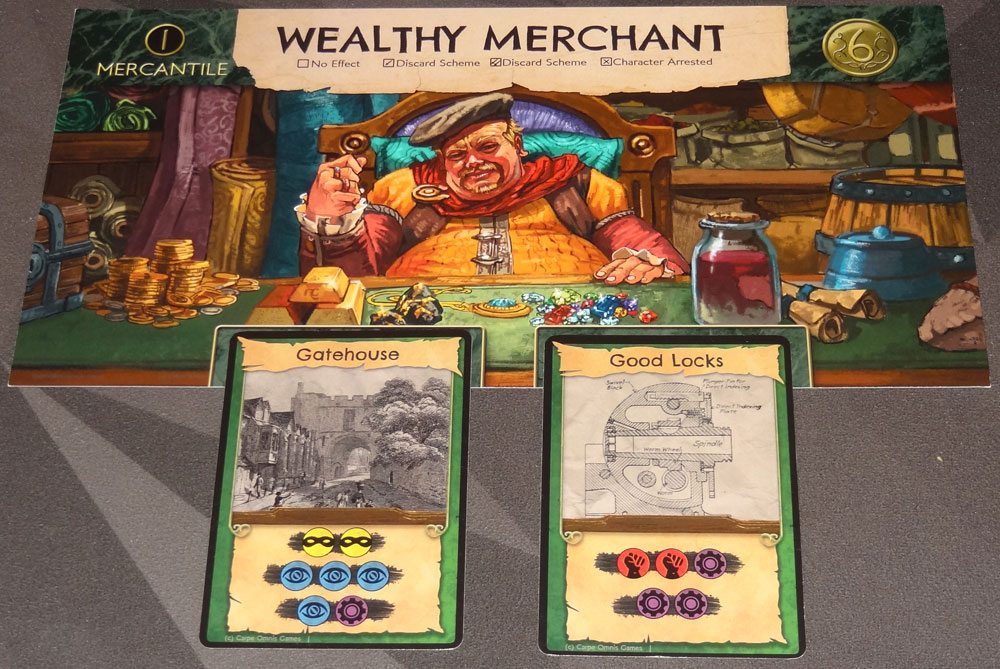
The Verdict
If you’ve watched any heist movies, you know how it goes: the mastermind cases the joint and comes up with a plan, and brings in all the specialists. Guards? No problem—sneak through the shadows, or sweet talk your way past them. Locks? Pick them, or maybe brute force them. And then once the job is done, make your getaway and split the loot. Simple, right? Until Ed Norton betrays you all, takes all the money for himself, and then leaves you all for dead. (Well that’s how one of them goes, anyway.)
No Honor Among Thieves aims to reproduce that feeling of assembling a crew, dealing with unexpected complications, and negotiating the division of labor and loot. And, of course, the sudden-but-inevitable betrayals.
Although there are a lot of rules to read, the mechanics aren’t too complex. Each Objective has defenses, and you can see what skills are needed to get past each one. I like that most defenses have multiple ways to defeat them—you can usually get past human guards with lies, stealth, or strength. Most of your actions (aside from the heist itself) are quite simple and short: hire a new crew member, draw some more cards, rest to refresh your exhausted characters, and so on. The only thing that makes things take longer is that you have to stop to read all of the cards—you’ll want to know all of the available characters (in the hiring pool and in the Jail) to see if you might want to hire somebody, and if you take a Legwork action to draw more Scheme cards, you’ll probably need to spend a little time looking over those before you decide whether to attempt a heist.

The actual heist portion is the real meat of the game, of course. You evaluate the risks and rewards, look around at everyone’s crew and see if you think you can overcome all the defenses—and then you have to convince other people to join your crew if you need some help. Since you can only have four characters in your own crew, chances are that you will need some help, particularly if there are difficult defenses on an Objective. But how much do you pay somebody to join you? And how many people do you invite?
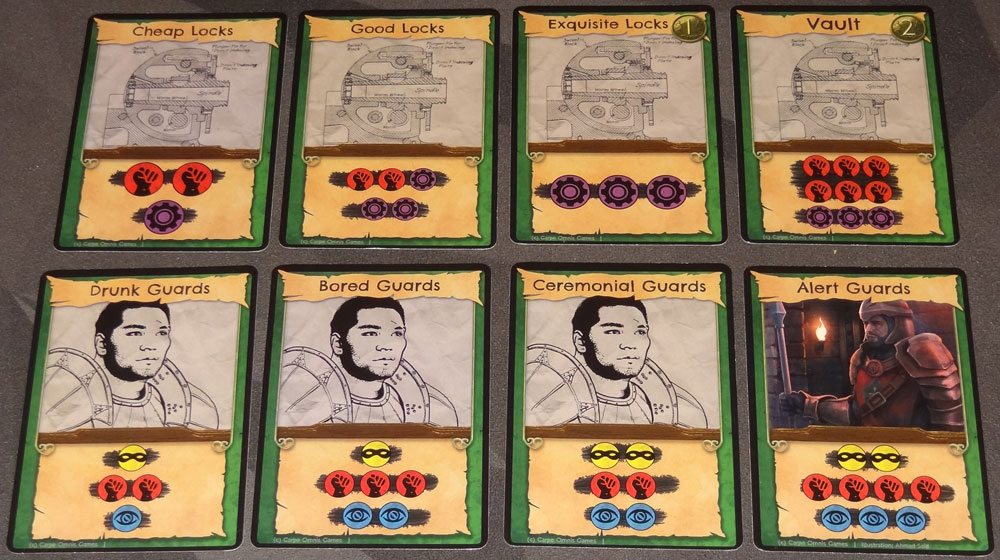
Your character abilities and Scheme cards can help you overcome defenses—but beware of cutting people out of the job, because they have Scheme cards that can add complications. That Drunk Guard you thought you’d be able to breeze by? Well, it turns out security was beefed up and he was replaced with a fancy new lock that doesn’t have a drinking problem. Your Polymath brings a lot of skills to the job, but somebody talked and he’s been arrested. The Complications phase of the heist is where everyone on the job holds their breath to see whether anyone else is going to make things more difficult—and if so, they gotta come up with Plan B. Or C.
And then, after all that work, one of the players might betray you all anyway. The Moment of Truth cards throw an interesting twist, because everyone is required to play a card face-down. They might just be regular Scheme cards that don’t do anything during the Moment of Truth, or they might mean that you betray your teammates and swipe a huge share of the loot. (We called “Betrayal” the “Ed Norton card.”) Of course, there are a couple of other Moment of Truth cards that can serve as insurance. “Safe Ground” cancels Betrayal cards. “Paranoia” lets you steal from anyone who betrayed you … but if nobody betrayed you, you owe everyone else money for being so paranoid. “Side Job” will get you two extra coins from the bank, without really affecting any of the other players directly.
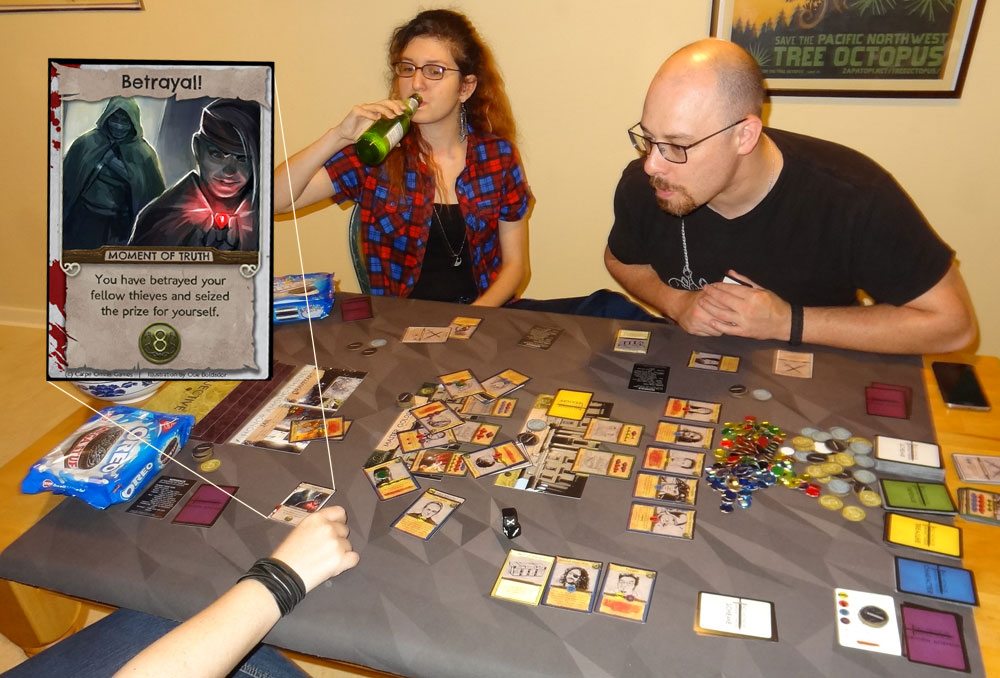
I will mention that there’s one single card, “Magnificent Betrayal,” that I thought was overpowered and not as much fun: it overrides all other Betrayal cards, lets you steal 14 coins from the share, and also trumps cards like “Safe Ground.” That’s a lot of coins—enough to get you the win if you were in the running, and there’s not much anyone can do about it. There are a few cards that may let you manipulate somebody else’s hand, but the likelihood of having one of those and ensuring that nobody has a Magnificent Betrayal before going on a heist seems pretty slim. It’s not as fun playing for two hours, scheming and planning, and then have the entire game decided by a single card on the last turn anyway. The card might be tweaked or removed from the game, but I would recommend either leaving it out, or making sure right from the beginning that everyone knows it exists and how it works, because if somebody suddenly springs that at the end of a long game, I guarantee there will be people who won’t be happy about it.
Aside from that card, though, the Moment of Truth is a great mechanic and really does a good job of capturing the thematic idea that thieves will try to get away with more than their fair share.

I will also mention, though, that I think you need players who are willing to steal and lie to each other if you really want to enjoy the game. It is, after all, called No Honor Among Thieves. If you play nice and never betray each other, it is actually kind of boring because then it’s entirely negotiation and cooperating on heists—it becomes more about who makes the best deals or maybe has the best crew. Plus, you won’t get to use any of those red-highlighted abilities on your Characters and Scheme cards. Your mileage may vary, but I personally think there are better cooperative games out there, and I don’t see the point of playing a backstabby heist game without the backstabbing.
I also think it works best with more than 3 players, though I don’t have a lot of data points for that. In a 3-player game, you will often have two people on a heist and a third one left out of the deal—because, after all, how will you ever win if you cut all the players in on every deal? But the 1-vs-2 dynamic means that it’s often very hard for the single player to complicate a scheme enough to cause it to fail when there are two other players cooperating to succeed. Once you add at least one more player, then things can get really interesting: in a 2-vs-2 situation, both sides may have some Scheme cards to play, and there’s a little more back-and-forth before people pass.

The connection between the theme and the mechanics is pretty great—most of the Characters do what you’d expect them to do, Defenses require the right sorts of skills to defeat, and the Scheme cards are all tactics you’d expect to find in a thief’s repertoire. The Hidden Agendas award bonus points at the end of the game if you accomplish them, and they’re also thematically appropriate: the Informant gives you bonus points for every Character who’s in Jail by the end of the game; the Fence gives you bonus coins for every Treasure card you acquired.
I did feel that the game can take a long time to play—though of course that depends a lot on the people you’re playing with, and your preferences about game length. (Generally my sweet spot for game length is about an hour.) If you let the negotiation phase drag out because people just can’t agree on terms, or if everyone keeps piling on complications for every heist and people keep failing, then the game will drag on. However, I’m also not entirely sure how to shorten it—I considered just removing a few of the Stage 1 and Stage 2 Objectives so that you’d get to Stage 3 more quickly, but even as it is, Stage 3 shows up after only four successful heists. Fewer than that may not be enough to give everyone enough opportunities to attempt heists or build up their crews. And it will take a while to teach the first time you play it—the rules aren’t hard, but there are a lot of them, and a lot of little details.
Overall, No Honor Among Thieves is a highly thematic game of heists, filled with devious tricks and shifting alliances. If you like games that involve stabbing your friends in the back, this will be right up your alley. For more information about the game or to make a pledge, visit the No Honor Among Thieves Kickstarter page.
Disclosure: I received a prototype of this game for review purposes.





Thanks for the review, Jonathan!
Over the course of development I went back and forth on how to handle Magnificent Betrayal. By the time I sent it your way, I thought I’d gotten it nailed down, but after your experiences with it I think I’m going to have to modify it again for the final version. Or maybe just get rid of it, if I decide it’s more trouble than it’s worth. We’ll see how it goes.
With that one small exception, I’m glad you enjoyed the game!
-Adam
I was thinking that Magnificent Betrayal may work best as a “burn it all down” card where nobody gets money or perhaps the betrayer gets a smaller amount—the reward offsets its power to cancel other Betrayals. That’s why I really liked Paranoia—it’s great if you get betrayed, but costs you if you’re wrong.